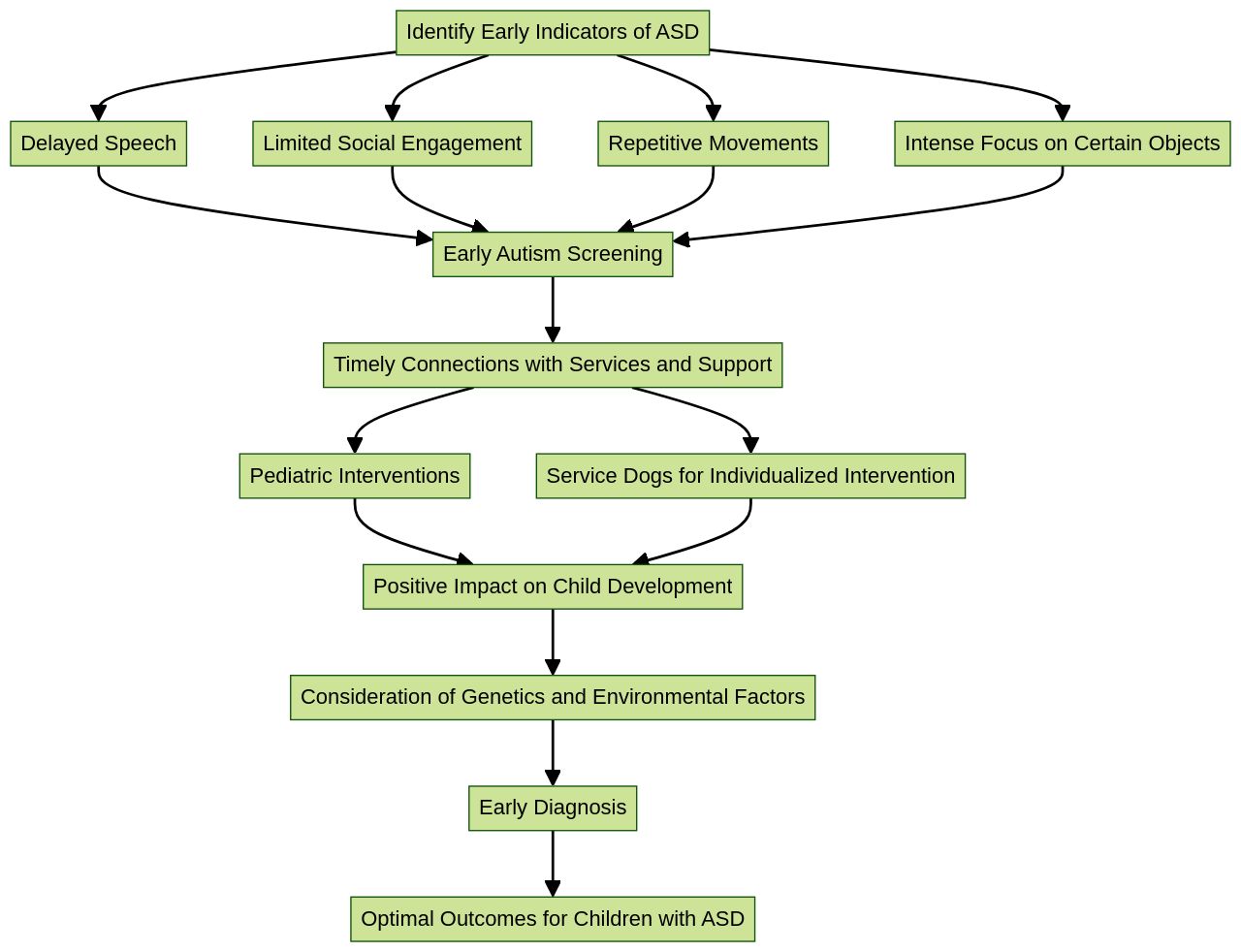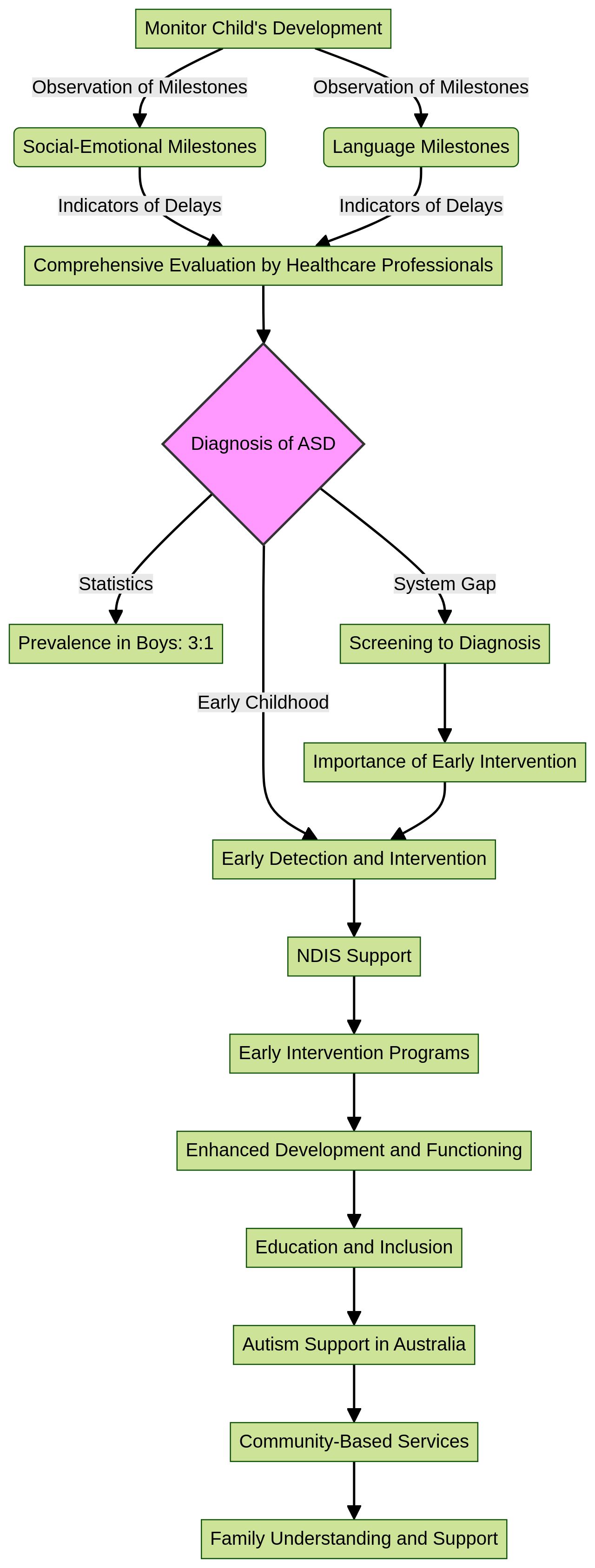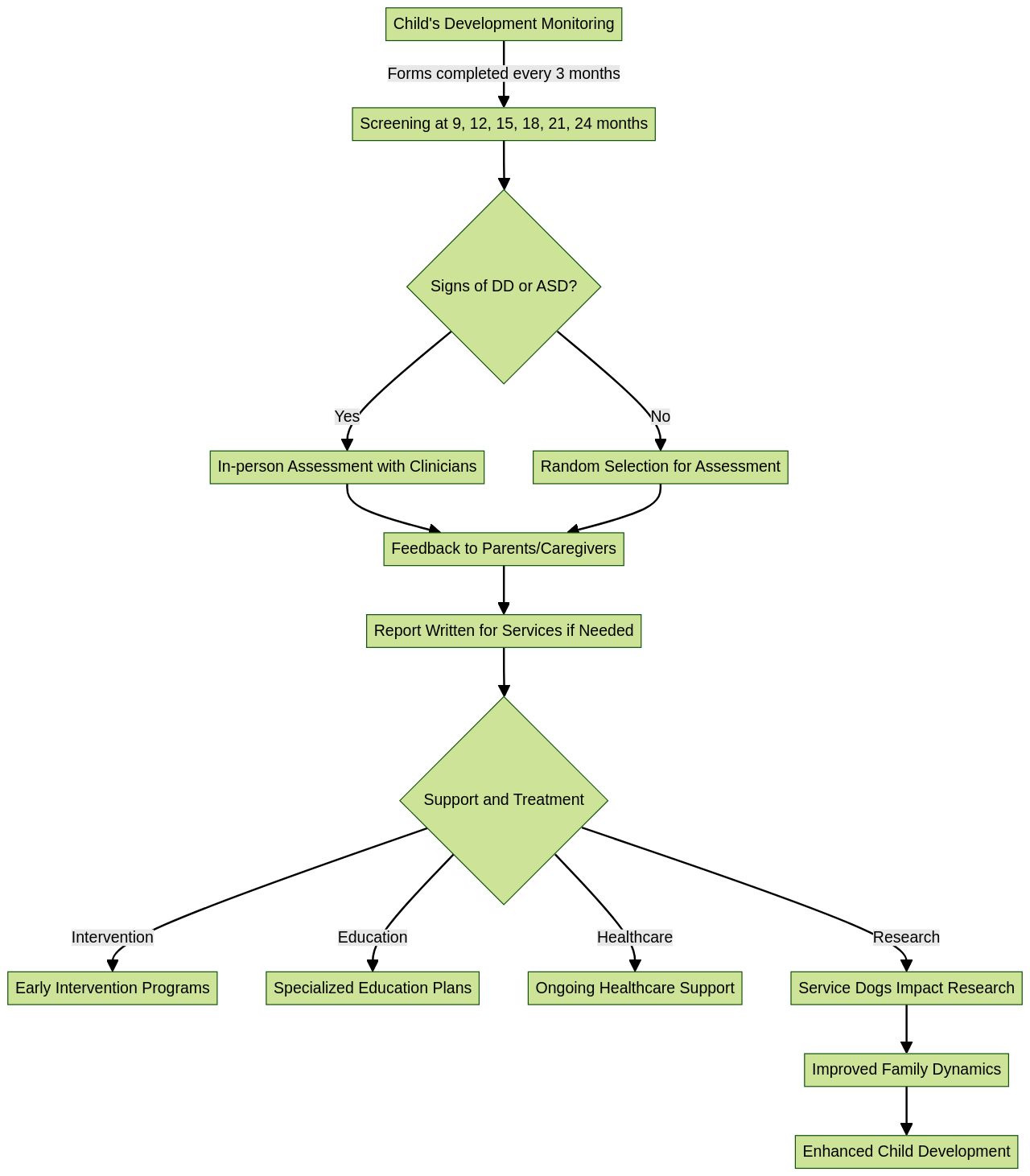Introduction
Autism Spectrum Disorder (ASD) is a complex neurodevelopmental condition that presents numerous challenges for individuals and their families. However, recent groundbreaking research has shed light on the positive impact that service dogs can have on the well-being of children with ASD and their families as a whole.
This article explores the findings of these studies and highlights the importance of early detection and intervention in improving outcomes for individuals with autism. Additionally, it emphasizes the significance of monitoring developmental milestones and implementing effective screening strategies to ensure that children with autism receive the support they need as early as possible.
Understanding Autism Spectrum Disorder
Autism Spectrum Disorder (ASD) is a complex neurodevelopmental condition, presenting a mosaic of challenges that can include difficulties with social communication, repetitive behaviors, and sensory sensitivities. The condition has been the focus of a groundbreaking study published in Frontiers of Psychiatry by Dr. Maggie O'Haire's lab, which delved into the experiences of families with ASD children. The study revealed that service dogs provide invaluable support, not only to the child with autism but to the entire family unit, enhancing emotional well-being and fostering resilience.
These canine companions are considered integral family members, bringing joy and improving family interactions. The study aligns with recent findings in the field of psychology, where Professor Kenkichi Takase and Professor Eiichi Nojiri have expanded on the concepts of mental functionalities and their role in ASD. Their work, published in Perspectives on Psychological Science, suggests that understanding the brain's intricate connections can offer new insights into the condition.
Moreover, research indicates that early diagnosis of ASD can lead to early intervention, potentially improving outcomes for individuals. This is underscored by the fact that only a small percentage of those diagnosed before the age of 5 are able to live independently as adults. In the realm of the human-animal bond, there is an increasing recognition of the mutual benefits for both humans and animals, particularly in therapeutic settings.
A study assessing therapy dogs working with autistic children found no significant changes in stress indicators for the dogs, suggesting that these interactions can be safe and beneficial for the animals involved. The study emphasizes the importance of further research to ensure the welfare of therapy dogs in such interventions. These findings contribute to a holistic view of ASD, where the interplay between human support and animal-assisted therapy can play a transformative role in improving the lives of those affected by autism.
Early Warning Signs of Autism Spectrum Disorder
Understanding early indicators of Autism Spectrum Disorder (ASD) can be pivotal in providing timely support and interventions. Signs such as delayed speech and language skills, minimal eye contact, limited social engagement, repetitive movements, and intense focus on certain objects are often observed. These behaviors can be picked up during routine health checks, where healthcare providers assess a child's developmental milestones.
Groundbreaking research from the National Institute of Mental Health (NIMH) has highlighted the importance of embedding early autism screening into regular pediatric appointments. Such screenings can detect signs of autism in children as young as 12 to 14 months, facilitating early connections to vital services and support. Recent studies have also shown the positive impact service dogs can have on children with autism and their families.
Service dogs not only support the child with ASD but also enhance the emotional well-being and social interactions of the entire family, fostering resilience and joy. These findings are part of an innovative study conducted in collaboration with the OHAIRE Group from the University of Arizona College of Veterinary Medicine, emphasizing the significant role service dogs play as individualized interventions within a family unit. Despite the complex interplay of genetics and environmental factors contributing to ASD, early diagnosis and intervention remain crucial for optimal outcomes.

Key Social-Emotional and Language Milestones
The early identification of Autism Spectrum Disorder (ASD) hinges on vigilant monitoring of a child's development. Essential social-emotional and language milestones, such as responsive gestures, pretend play, and the use of names, are critical indicators.
Delays in these areas can signal the need for a comprehensive evaluation by healthcare professionals who are adept in discerning the nuances of communication and behavior associated with ASD. The DSM-5 underscores that the hallmarks of Autism manifest in early childhood, often before the age of three.
Yet, the real challenge lies in detecting these signs when social demands exceed a child's coping abilities or when compensatory strategies mask the symptoms. Statistics reveal that boys are disproportionately affected by ASD, with a diagnosis rate more than three times higher than that of girls.
Furthermore, developmental delays other than ASD or intellectual disability are more prevalent in boys and tend to decrease with age. The National Health Interview Survey from 2019 to 2021 has shown an increase in developmental disabilities among children, emphasizing the urgency of early detection and intervention.
Researchers and healthcare providers are developing new tools and strategies to embed early autism screening into routine pediatric visits, recognizing the importance of family-centered care. The American Academy of Pediatrics advocates for developmental monitoring, emphasizing the value of parental input as reliable sources of their child's progress. Indeed, the sooner children with autism receive a diagnosis, the earlier intervention can begin - a critical factor in the effectiveness of behavioral therapies. As studies indicate, a significant delay often occurs between initial screening and diagnosis, highlighting a gap in the system that requires attention. To address this, experts recommend screening all children with validated tools at recommended ages. This collective effort aims to connect children and families to support services as early as possible, enabling them to navigate the challenges associated with ASD with greater knowledge and resources.

Differentiating Between Shy Temperament and ASD
Understanding the nuances between introverted behaviors and Autism Spectrum Disorder (ASD) is vital, as they may appear similar but have different implications for a child's development. Shyness, often characterized by social reticence or anxiety in unfamiliar situations, contrasts with ASD, where challenges are more profound, affecting social communication and interactions consistently across contexts. A study led by Liesl Melnick at Eastern Illinois University investigated these differences, assessing 122 children through language tasks involving varying social demands.
It found that shy children's performance distinctly varied from those with ASD, emphasizing the importance of tailored approaches in education and social development. Teachers, therefore, need to cultivate inclusive environments that support both extroverted and introverted children, recognizing that developmental milestones are influenced by imitation and the social setting. Meanwhile, statistics show ASD's complex nature, with its prevalence being similar across demographics.
However, girls are less likely to be diagnosed, and intellectual capabilities among those with ASD vary widely. With ASD affecting individuals uniquely throughout their lives, early detection and intervention are crucial, though current research indicates a need for more proactive identification methods before 18 months of age. This underscores the significance of monitoring subtle behavioral changes to facilitate early support, which can profoundly impact the trajectory of a child's growth.
Effective Strategies for Autism Screening
The journey to understanding and supporting autism in young children is an evolving one, with a strong emphasis on early detection and intervention. A key component of this approach is the use of innovative tools such as the Modified Checklist for Autism in Toddlers (M-CHAT), designed to reveal early signs of autism.
These tools are becoming a routine part of pediatric care, allowing healthcare providers to assess developmental milestones and potential red flags. A multi-disciplinary approach involving healthcare professionals, educators, and parents is essential in implementing these screening strategies effectively.
Groundbreaking research underscores the importance of such collaborative efforts. A study conducted by Canine Companions in partnership with the OHAIRE Group reveals that service dogs provide a unique and individualized intervention for children with autism, enhancing social connections and reducing experiences of judgment and stigma for the entire family.
The study, published in Frontiers of Psychiatry, provides qualitative insights into the experiences of caretakers, highlighting the positive impact of service dogs on both the child with autism and their family's resilience. As we continue to explore new models of service delivery, it's clear that early and accurate screening tools are a cornerstone of supporting children with autism. Research, like the studies validating the EarliPoinT Evaluation tool, demonstrates the power of objective measurements in predicting expert clinician assessments and facilitating earlier, individualized treatment plans. This reflects a broader trend towards integrating early autism screening into routine health care, which can significantly benefit children and families by connecting them to support and services as early as possible.

Conclusion
In conclusion, recent groundbreaking research has highlighted the positive impact that service dogs can have on the well-being of children with Autism Spectrum Disorder (ASD) and their families. These canine companions are considered integral family members, bringing joy and improving family interactions.
Additionally, early detection and intervention play a crucial role in improving outcomes for individuals with autism. Understanding the early warning signs of ASD, such as delayed speech and language skills, minimal eye contact, and repetitive movements, can help parents provide timely support and interventions.
Monitoring key social-emotional and language milestones is also essential for identifying potential red flags. It is important to differentiate between shy temperament and ASD to ensure tailored approaches in education and social development.
Effective screening strategies, such as using tools like the Modified Checklist for Autism in Toddlers (M-CHAT), are essential in detecting signs of autism at an early age. Collaborative efforts involving healthcare professionals, educators, and parents are crucial in implementing these strategies effectively. The findings emphasize the significance of early and accurate screening tools in supporting children with autism and connecting them to vital services as early as possible. By being proactive in monitoring developmental milestones and implementing effective screening strategies, we can ensure that children with autism receive the support they need to thrive.




